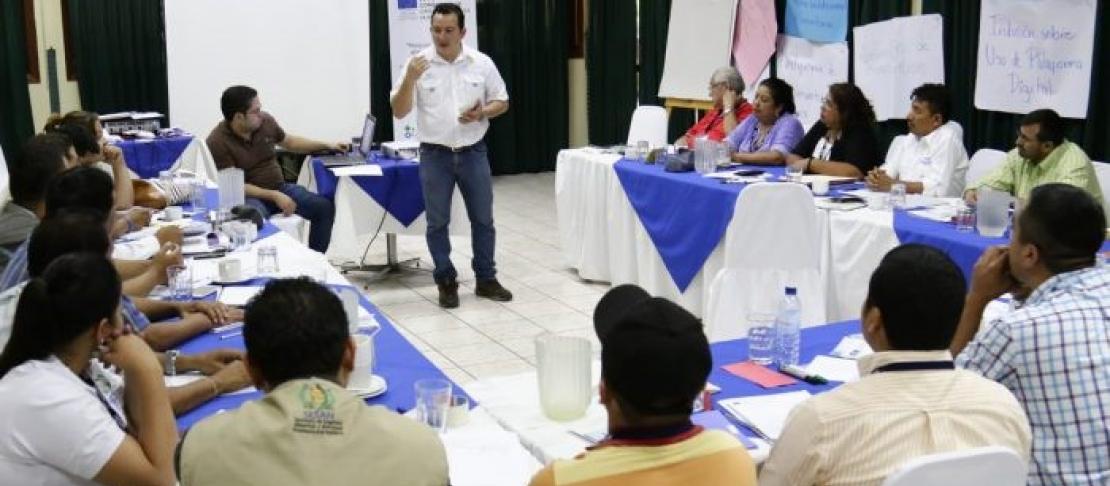Guatemala implements a food security monitoring and early warning system supported by Bioversity and CCAFS

The Guatemala Secretariat for Food and Nutrition Security implemented a digital platform to improve the management of and response to climate-related seasonal hunger at local scale.
The Guatemala Secretariat for Food and Nutrition Security (SESAN) recently started the nation-wide implementation of a food security monitoring and early warning system. The system was developed together with researchers from Bioversity International and the CGIAR Research Program on Climate Change, Agriculture and Food Security (CCAFS), and food security and climate risk management specialists from Action Against Hunger (ACH) under the AgroClimate project.
The tailored digital platform will support data collection, analysis and dissemination in all 340 municipalities in Guatemala to improve the management of and response to climate-related seasonal hunger at local scale.
In August 2018, SESAN together with Bioversity International, ACH, CATIE and Nexos Locales/USAID, started a capacity building process for all municipal extension officers that will use the system. The extension officers learned about the platform and its integration into the municipal food security governance mechanisms. The implementation of the digital platform for food security monitoring and early warning is an important political step that promotes the shift from reactive crisis response towards proactive climate risk and food security management.
A recurring problem in Guatemala: seasonal hunger increases with climate variability
Shifting patterns in duration and onset of the midsummer-drought that occurs during the rainy seasons regularly challenges subsistence farm families in Guatemala. Seasonal hunger and acute undernutrition are a recurring problem in the country. Just this year, an estimated 1.5 million people are at risk of increasing food insecurity due to partial or total losses in small-scale primary grain production. This problem is not new to the country. However, with increasing climate variability, occurrences of extended mid-summer droughts during the rainy season appear to be increasing, whereas the recovery time between unusual dry years is decreasing. Although seasonal hunger is a recurring and well-known problem, the official response is typically too late, uncoordinated and reactive.
Decision-makers need information from the communities to support actions
Timely and relevant information at the right scale is a key ingredient for detecting communities and families at risk as early as possible and for breaking the reactive approach to crisis management. Decision-makers have expressed the need to have more information on what happens in the communities at risk. Currently, drought and food security information is only available on a coarse scale. In addition, the Guatemalan food security law mandates the development and implementation of a local, community-based food security monitoring and early warning system.
Participatory co-design of a food security monitoring and early warning system
The three-year project worked with a participatory and iterative co-design process combining ethnographic methods, and qualitative and quantitative surveys in order to fully understand decision-makers’ needs, decision-making cycles and the surrounding context. Using prototyping techniques, we identified the information system that best matches the demand of users. Extension agents collect information on a minimum set of key variables that supports the main decisions around seasonal hunger at the local scale. The indicators have been selected together with decision-makers under the criteria of availability, data quality, and importance for decision-making. The information is coming from key informants and the local health center in selected communities, which are representative of the food security situation in a municipality.
Important decisions at the municipal level are, for example, the selection of communities and people at risk to prioritize interventions, or the definition of the recommended sowing date. Via mobile phone, the data is uploaded to the platform and analyzed using a customized algorithm to come up with an estimation of the food security situation according to four alert levels. Essential information, the alert level, and recommendations are gathered in a report that is then distributed among key decision-makers in the municipalities to support decision making.
Political support and implementation at scale
What was meant to be a solution for drought and food security management in selected municipalities in the Guatemalan Dry Corridor received widespread political interest during the last months, and SESAN decided to implement the system at scale in all municipalities of the country. In September 2018, SESAN presented the initiative to the National Council for Food and Nutrition Security (CONASAN). The CONASAN includes the vice president and all ministers from ministries related to food security and is the governing body relating the food security policy of the country. The council fully endorsed the initiative, which reflects its importance for Guatemalan food security legislation.
Next steps are planned to strengthen SESAN's capacities in maintaining the system and to search for possibilities to extend the information flow to actors at the national level. Furthermore, other countries have already showed interest in the system for their drought and food security management.
Read more:
Anna Muller is a Researcher at Bioversity International in the AgroClimate project from the CCAFS Flagship on Climate Service and Safety Nets.



